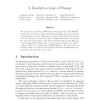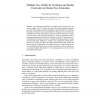108 search results - page 7 / 22 » Combining Spatial and Terminological Reasoning |
IJCAI
2007
15 years 1 months ago
2007
We combine the modal logic S5 with the description logic (DL) ALCQI. In this way, we obtain a multi-dimensional DL, S5ALCQI, whose purpose is reasoning about change. S5ALCQI is ca...
ECCV
2008
Springer
16 years 1 months ago
2008
Springer
Abstract. Tree-structured models have been widely used for human pose estimation, in either 2D or 3D. While such models allow efficient learning and inference, they fail to capture...
NGC
2006
Springer
14 years 11 months ago
2006
Springer
This paper examines two seemingly unrelated qualitative spatial reasoning domains; geometric proportional analogies and topographic (landcover) maps. We present a Structure Matchin...
97
Voted
ECCV
2010
Springer
15 years 4 months ago
2010
Springer
Abstract. Computer vision algorithms for individual tasks such as object recognition, detection and segmentation have shown impressive results in the recent past. The next challeng...
104
click to vote
GEOINFORMATICA
2008
14 years 11 months ago
2008
Topological relationships like overlap, inside, meet, and disjoint uniquely characterize the relative position between objects in space. For a long time, they have been a focus of...


